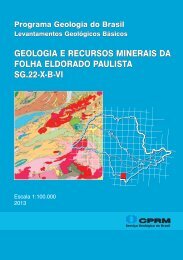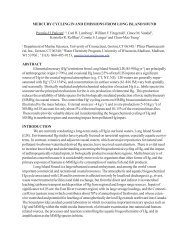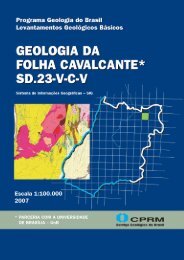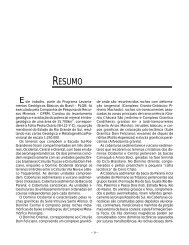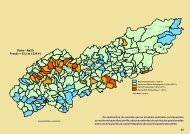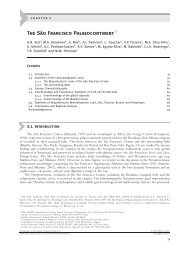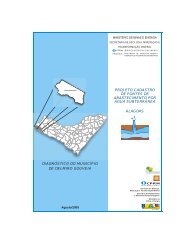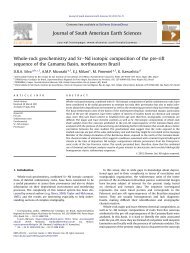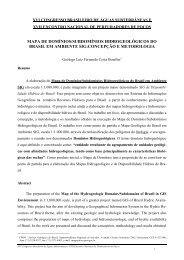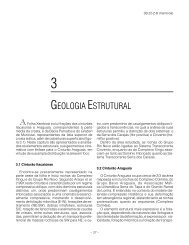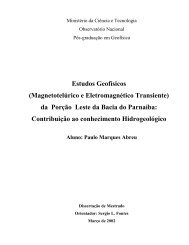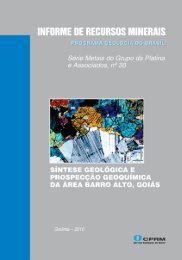Origin of the CO2-only fluid inclusions in the ... - CPRM
Origin of the CO2-only fluid inclusions in the ... - CPRM
Origin of the CO2-only fluid inclusions in the ... - CPRM
You also want an ePaper? Increase the reach of your titles
YUMPU automatically turns print PDFs into web optimized ePapers that Google loves.
34 E.L. Kle<strong>in</strong>, K. Fuzikawa / Ore Geology Reviews 37 (2010) 31–40<br />
granitoids. The regional foliation is parallel to <strong>the</strong> major tectonic discont<strong>in</strong>uities.<br />
However, <strong>in</strong> places, it is parallel to <strong>the</strong> contacts between <strong>the</strong><br />
supracrustal sequences and <strong>the</strong> granitoid plutons. This schistosity has<br />
overpr<strong>in</strong>ted primary structures (bedd<strong>in</strong>g) <strong>of</strong> <strong>the</strong> rocks, which are no<br />
longer recognized. A down dip to slightly oblique elongation l<strong>in</strong>eation is<br />
conta<strong>in</strong>ed <strong>in</strong> <strong>the</strong> foliation planes. Slickenl<strong>in</strong>e planes are also present,<br />
especially at <strong>the</strong> contact between ve<strong>in</strong>s and <strong>the</strong>ir host rocks. The schistosity<br />
is locally folded <strong>in</strong>to open to recumbent folds. A strike–slip movement<br />
is evident especially along <strong>the</strong> boundary between <strong>the</strong> Carecuru<br />
Doma<strong>in</strong> and <strong>the</strong> Amapá Block, overpr<strong>in</strong>t<strong>in</strong>g early thrust structures and<br />
show<strong>in</strong>g both dextral and s<strong>in</strong>istral k<strong>in</strong>ematic features. However, <strong>in</strong> <strong>the</strong><br />
<strong>in</strong>ner portions <strong>of</strong> <strong>the</strong> supracrustal sequences, steep l<strong>in</strong>eations dom<strong>in</strong>ate,<br />
suggest<strong>in</strong>g limited strike–slip <strong>in</strong>fluence dur<strong>in</strong>g <strong>the</strong> ductile deformation.<br />
These structural elements likely record a compressive deformation event,<br />
show<strong>in</strong>g effects <strong>of</strong> NE–SW shorten<strong>in</strong>g (D1) followed by <strong>the</strong> transcurrent<br />
regime (D2). Second- and third-order structures are present as well, be<strong>in</strong>g<br />
both parallel and oblique to <strong>the</strong> strike <strong>of</strong> <strong>the</strong> first-order ones. These<br />
subsidiary structures are dom<strong>in</strong>antly moderate to high-angle reverse to<br />
reverse-oblique <strong>in</strong> nature (Kle<strong>in</strong> and Rosa-Costa, 2003). The strike–slip<br />
structures (D2) were active by 2030±2 Ma, which is constra<strong>in</strong>ed by <strong>the</strong><br />
<strong>in</strong>trusion <strong>of</strong> syn-tectonic muscovite- and/or garnet-bear<strong>in</strong>g crustal<br />
granites (Fig. 1)(Rosa-Costa et al., 2006).<br />
4. The Carará deposit<br />
4.1. Local geology<br />
M<strong>in</strong>eralisation <strong>in</strong> <strong>the</strong> Ipit<strong>in</strong>ga Auriferous District is closely related to<br />
two sets <strong>of</strong> supracrustal sequences, <strong>the</strong> Ipit<strong>in</strong>ga Group and <strong>the</strong><br />
Fazend<strong>in</strong>ha Sequence (Fig. 1). M<strong>in</strong>eralised structures <strong>in</strong> <strong>the</strong> district<br />
have been <strong>in</strong>terpreted to be related to <strong>the</strong> evolution <strong>of</strong> <strong>the</strong> Ipit<strong>in</strong>ga<br />
l<strong>in</strong>eament (Kle<strong>in</strong> and Rosa-Costa, 2003). The Carará gold deposit is<br />
located <strong>in</strong> <strong>the</strong> south-eastern portion <strong>of</strong> <strong>the</strong> Ipit<strong>in</strong>ga Auriferous District<br />
and is hosted <strong>in</strong> a metasedimentary rock <strong>of</strong> <strong>the</strong> Ipit<strong>in</strong>ga Group close to<br />
<strong>the</strong> tectonic limit between <strong>the</strong> Carecuru Doma<strong>in</strong> and <strong>the</strong> Amapá Block. In<br />
<strong>the</strong> vic<strong>in</strong>ities <strong>of</strong> <strong>the</strong> deposit <strong>the</strong> Ipit<strong>in</strong>ga Group is tectonically juxtaposed<br />
to <strong>the</strong> Guianense Complex along <strong>the</strong> Ipit<strong>in</strong>ga l<strong>in</strong>eament. Both units have<br />
been <strong>in</strong>truded by <strong>the</strong> Carecuru Intrusive Suite and leucogranites (Fig. 1).<br />
4.2. Deposit geology<br />
The Carará deposit had been m<strong>in</strong>ed for several years until m<strong>in</strong>e closure<br />
<strong>in</strong> <strong>the</strong> beg<strong>in</strong>n<strong>in</strong>g <strong>of</strong> <strong>the</strong> 1990's. Geological resources <strong>of</strong> 10 tonnes Au have<br />
been determ<strong>in</strong>ed (Carvalho et al., 1995) and gold grades <strong>in</strong> <strong>the</strong> ve<strong>in</strong> and<br />
wall-rock vary significantly along <strong>the</strong> strike, from 2.72 to 53.42 g/t and<br />
0.18 to 17.21 g/t, respectively (Fig. 2). A better understand<strong>in</strong>g <strong>of</strong> <strong>the</strong><br />
geological conditions around <strong>the</strong> deposit is hampered by <strong>the</strong> thick lateritic<br />
cover. Gold m<strong>in</strong>eralisation is associated with a quartz ve<strong>in</strong> and its 10 to<br />
50 cm-thick hydro<strong>the</strong>rmal halo. The wall-rock is a tourmal<strong>in</strong>e- and<br />
muscovite-bear<strong>in</strong>g quartzite with subord<strong>in</strong>ate pyrite content (Fig. 3). The<br />
quartzite shows a NNW–SSE-strik<strong>in</strong>g schistosity that dips 75° to 85° to <strong>the</strong><br />
SW. The schistosity is def<strong>in</strong>ed by <strong>the</strong> preferred orientation <strong>of</strong> muscovite<br />
crystals and is conformable to <strong>the</strong> regional foliation. The schistosity planes<br />
conta<strong>in</strong> an elongation l<strong>in</strong>eation that plunges at high angles <strong>in</strong>, or slightly<br />
oblique to, <strong>the</strong> dip direction (70°S/30°W).<br />
The gold–quartz ve<strong>in</strong> shows variable thickness, from 15 cm to 3 m<br />
(Figs. 2 and 4), and can be traced by more than 400 m along strike, and at<br />
least by 70 m <strong>in</strong> depth. The quartz ve<strong>in</strong> occupies <strong>the</strong> central part <strong>of</strong> a<br />
shear zone, which is def<strong>in</strong>ed by large contents <strong>of</strong> muscovite and tourmal<strong>in</strong>e<br />
close to <strong>the</strong> ve<strong>in</strong> walls (Fig. 4A). Both muscovite and tourmal<strong>in</strong>e<br />
gra<strong>in</strong>s def<strong>in</strong>e an elongation l<strong>in</strong>eation that <strong>in</strong>dicates reverse to slightly<br />
reverse-oblique movement along <strong>the</strong> ve<strong>in</strong>, characteriz<strong>in</strong>g a high-angle<br />
reverse shear zone, and suggest that <strong>the</strong> shear zone was active at <strong>the</strong><br />
time <strong>of</strong> ve<strong>in</strong> formation. These features allow <strong>the</strong> quartz ve<strong>in</strong> be classified<br />
as a central shear ve<strong>in</strong>, accord<strong>in</strong>g to Hodgson (1989). The ve<strong>in</strong> shows<br />
massive to saccharoidal textures and <strong>the</strong> absence <strong>of</strong> lam<strong>in</strong>ated texture<br />
with fragments <strong>of</strong> <strong>the</strong> wall-rock <strong>in</strong>side <strong>the</strong> ve<strong>in</strong> may suggest a s<strong>in</strong>gle<br />
stage <strong>of</strong> dilation and hydro<strong>the</strong>rmal seal<strong>in</strong>g (e.g., Cox, 1995). In addition,<br />
saccharoidal texture <strong>in</strong>dicates, at least moderate crustal levels (mesozonal)<br />
for ve<strong>in</strong> emplacement.<br />
Tourmal<strong>in</strong>e forms well developed layers at <strong>the</strong> contact between <strong>the</strong><br />
ve<strong>in</strong> and <strong>the</strong> wall-rock (Fig. 4A), and two types can be observed. One<br />
type forms aggregates <strong>of</strong> small dark-green prismatic crystals. The o<strong>the</strong>r<br />
type is formed by larger and more limpid brownish crystals hav<strong>in</strong>g less<br />
solid <strong><strong>in</strong>clusions</strong> than <strong>the</strong> dark-green ones. Both types may occur <strong>in</strong><br />
spatial association and both are associated with quartz. Muscovite occurs<br />
as small platy and oriented crystals, and sulphide m<strong>in</strong>erals (pyrite) are<br />
Fig. 2. Sketch map <strong>of</strong> level 70, shaft 3 <strong>of</strong> <strong>the</strong> Carará gold deposit show<strong>in</strong>g <strong>the</strong> variation <strong>in</strong> gold grades along <strong>the</strong> quartz ve<strong>in</strong> and host quartzite. The subdivisions are schematic and are<br />
based on 30 analyses.



